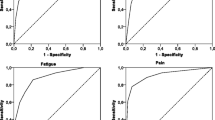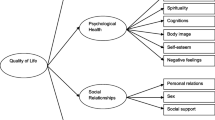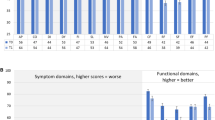Abstract
Aims
To evaluate the reliability and validity of the European Organization for Research and Treatment of Cancer (EORTC) QLQ-C30 and LC13 questionnaire in a palliative setting, and to undertake a broad clinical evaluation of the questionnaire.
Patients
One hundred and twelve patients with advanced lung cancer or pleural mesothelioma, not amenable to curative or life-prolonging treatment, were consecutively included.
Methods
Construct validity and reliability of the EORTC questionnaire were examined by multitrait analysis and internal consistency. Criterion validity was examined by variance by and correlation with an array of clinical measures, including tumour stage, performance status, 6-min walk test, spirometry, and blood tests. Concurrent validity was evaluated by established scales for emotional distress and pain.
Results
With the exception of cognitive functioning, reliability and construct validity of the QLQ-C30 was confirmed. Criterion and concurrent validity was supported for most of the functioning and symptom scales. In a multivariate stepwise regression analysis, EORTC physical functioning was predicted by performance status and 6-min walk distance (r 2 = .70), emotional functioning by HADS anxiety ratings (r 2 = .59), and global quality of life by performance status, HADS depression ratings, and FEV1 %predicted (r 2 = .50).
Conclusion
The results support the validity and clinical relevance and of the EORTC questionnaire in a palliative setting.


Similar content being viewed by others
Abbreviations
- HRQL:
-
Health-related quality of life
- EORTC:
-
The European organisation for research and treatment of cancer
- HADS:
-
The hospital anxiety and depression scale
- BPI:
-
The brief pain inventory
- BMI:
-
Body mass index
- KPS:
-
Karnofsky performance scale
- WHO:
-
The world health organisation
- SE:
-
Standard error
- NSCLC:
-
Non-small cell lung cancer
- SCLC:
-
Small cell lung cancer
- FEV1:
-
Forced exspiratory volume in 1 s
- FEV1 %pred:
-
FEV1 in % of predicted value
- B-Hb:
-
Blood haemoglobin
- SpO2 :
-
Percutaneous oxygen saturation
References
Morrow, G. R., Lindke, J., & Black, P. (1992). Measurement of quality of life in patients: psychometric analyses of the functional living index-cancer (FLIC). Quality of Life Research, 1, 287–296.
Cella, D. F., Tulsky, D. S., Gray, G., et al. (1993). The functional assessment of cancer therapy (FACT) scale: Development and validation of the general measure. Journal of Clinical Oncology, 11, 570–579.
Hollen, P. J., Gralla, R. J., Kris, M. G., Cox, C., Belani, C. P., & Grunberg, S. M., et al. (1994). Measurement of quality of life in patients with lung cancer in multicenter trials of new therapies. Psychometric assessment of the Lung Cancer Symptom Scale Cancer, 73, 2087–2098.
Aaronson, N. K., Ahmedzai, S., Bergman, B., Bullinger, M., Cull, A., Duez, N., et al. (1993). The European organization for research and treatment of cancer QLQ-C30: A quality-of-life instrument for use in international clinical trials in oncology. Journal of the National Cancer Institute, 85, 365–376.
Bergman, B., Aaronson, N. K., Ahmedzai, S., Kaasa, S., & Sullivan, M. (1994). The EORTC QLQ-LC13: A modular supplement to the EORTC core quality of life questionnaire (QLQ-C30) for use in lung cancer clinical trials. European Journal of Cancer, 30, 635–642.
de Haes, J., Curran, D., Young, T., Bottomley, A., Flechtner, H., Aaronson, N., et al. (2000). Quality of life evaluation in oncological clinical trials–the EORTC model. The EORTC quality of life study group. European Journal of Cancer, 36, 821–825.
Osoba, D., Zee, B., Pater, J., Warr, D., Kaizer, L., & Latreille, J. (1994). Psychometric properties and responsiveness of the EORTC quality of life questionnaire (QLQ-C30) in patients with breast, ovarian and lung cancer. Quality of Life Research, 3, 353–364.
Osoba, D., Rodrigues, G., Myles, J., Zee, B., & Pater, J. (1998). Interpreting the significance of changes in health related quality of life scores. Journal of the Clinical Oncology, 16, 139–144.
Zigmond, A. S., & Snaith, R. P. (1983). The hospital anxiety and depression scale. Acta Psychiatrica Scandinavica, 67, 361–370.
Daut, R. L., Cleeland, C. S., & Flanery, R. C. (1983). Development of the Wisconsin brief pain questionnaire to assess pain in cancer and other diseases. Pain, 17, 197–210.
The EORTC QL Group website. www.eortc.be/home/qol.
Sjösteen, A., Lundqvist, C., blomstrand, C., Sullivan, L., & Sullivan, M. (1990). The quality of life of three functional spinal cord injury subgroups in a swedish community. Paraplegia, 28, 476–488.
Bergman, B., Sullivan, M., & Sörenson, S. (1991). Quality of life during chemotherapy for small cell lung cancer. I. An evaluation with generic health measures. Acta Oncologica, 30, 947–957.
Hammerlid, E., Ahlner-Elmqvist, M., Bjordal, K., Biorklund, A., Evensen, J., Boysen, M., et al. (1999). A prospective multicentre study in Sweden and Norway of mental distress and psychiatric morbidity in head and neck cancer patients. British Journal of Cancer, 80, 766–774.
Bernhard, J., Sullivan, M., Hurny, C., Coates, A. S., & Rudenstam, C. M. (2001). Clinical relevance of single item quality of life indicators in cancer clinical trials. British Journal of Cancer, 84, 1156–1165.
Bergenmar, M., Nilsson, B., Hansson, J., & Brandberg, Y. (2004). Anxiety and depressive symptoms measured by the hospital anxiety and depression scale as predictors of time to recurrence in localized cutaneous melanoma. Acta Oncologica, 43, 161–168.
Karnofsky, D. A., & Burchenal, J. H. (1949). The clinical evaluation of chemotherapeutic agents in cancer. In C. M. McLeod (Ed.), Evaluation of chemotherapeutic agents in cancer (pp. 191–205). New York: Columbia University Press.
WHO. (1979). Handbook for reporting results of cancer treatment. Geneva: WHO.
Cronbach, L. J. (1951). Coefficient alpha and the internal structure of tests. Psychometrica, 16, 297–334.
Cohen J. (1988). Statistical power analysis for the behavioral sciences. Hillsdale, NJ: Lawrence Erlbaum Associates.
Fayers, P., Weeden, S., & Curran, D. (1998). On behalf of the EORTC quality of life study group. EORTC QLQ-C30 reference values. Brussels: EORTC.
Osoba, D., Aaronson, N., Zee, B., Sprangers, M., & te Velde, A. (1997). Modification of the EORTC QLQ-C30 (version 2.0) based on content validity and reliability testing in large samples of patients with cancer. The study group on quality of life of the EORTC and the symptom control and quality of life committees of the NCI of Canada clinical trials group. Quality of Life Research, 6, 103–108.
Billingham, L. J., & Cullen, M. H. (2001). The benefits of chemotherapy in patient subgroups with unresectable non-small-cell lung cancer. Annals of Oncology, 12, 1671–1675.
Jones, P. W., & Bergman, B. (1990). Quality of life assessment in COPD. Poor correlation between spirometry and patient ratings. Lakartidningen, 87, 1372–1375.
Groenvold, M., Petersen, M. A., Aaronson, N., Arraras, J. L., Blazeby, J. M., Bottomley, A., et al. (2006). The development of the EORTC QLQ-C15-PAL: A shortened questionnaire for cancer patients in palliative care. European Journal of Cancer, 42, 55–64.
Petersen, M. A., Groenvold, M., Aaronson, N., Blazeby, J., Brandberg, Y., de Graeff, A., et al. (2006). Item response theory was used to shorten EORTC QLQ-C30 scales for use in palliative care. Journal of Clinical Epidemiology, 59, 36–44.
Stromgren, A. S., Goldscmidt, D., Groenvold, M., Petersen, M. A., Jensen, P. T., Pedersen, L., et al. (2002). Self-assessment in cancer patients referred to palliative care: a study of feasibility and symptom epidemiology. Cancer, 94, 512–520.
Lund Hagelin, C., Seiger, A., & Furst, C. J. (2006). Quality of life in terminal care–with special reference to age, gender and marital status. Support Care Cancer, 14, 320–328.
Acknowledgement
The study was supported by the Swedish Cancer Foundation
Author information
Authors and Affiliations
Corresponding author
Rights and permissions
About this article
Cite this article
Nicklasson, M., Bergman, B. Validity, reliability and clinical relevance of EORTC QLQ-C30 and LC13 in patients with chest malignancies in a palliative setting. Qual Life Res 16, 1019–1028 (2007). https://doi.org/10.1007/s11136-007-9210-8
Received:
Accepted:
Published:
Issue Date:
DOI: https://doi.org/10.1007/s11136-007-9210-8




